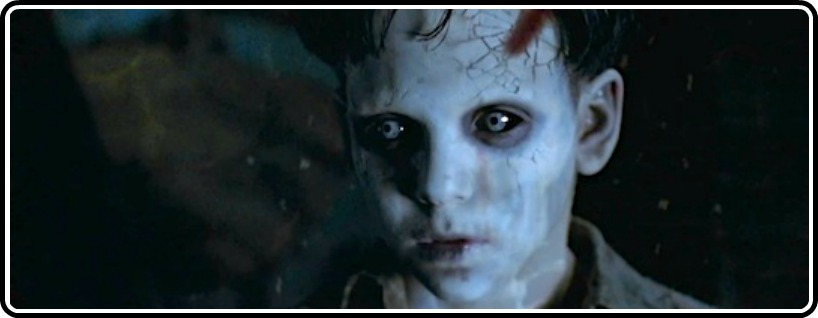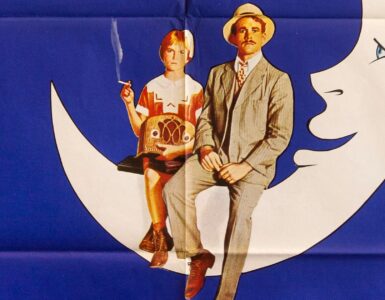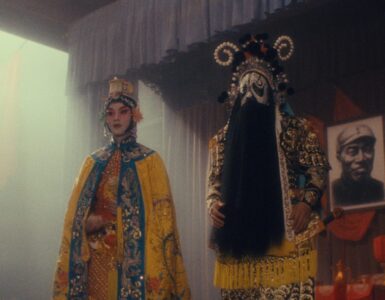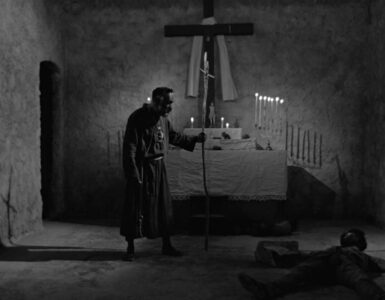Now going on his 20th year as a feature length filmmaker, with his first feature, 1993’s Cronos now two decades old, filmmaker Guillermo del Toro has become one of the most beloved genre filmmakers of his time. With big blockbusters (the underwhelming Pacific Rim) and genuinely affecting fairy tale-like dramas (the brilliant Pan’s Labyrinth) under his belt, he’s become a cinephile favorite, and a director whose style is as assured and singular as any today.
And now, thankfully, we have a brand new home video release of the director’s true masterpiece, his third film The Devil’s Backbone. And boy, is it a doozy.
Del Toro’s most personal picture, and a spiritual cousin to his Oscar nominated Labyrinth, The Devil’s Backbone follows a story one sees del Toro riff on throughout his career as both filmmaker and film producer (one of his best known productions, The Orphanage, very much feels like a similar spiritual descendant of this film). Carlos (beautifully played by an actor far beyond his years, Fernando Tielve), a 12-year old boy, has recently lost his father, and we find him on his way to a boy’s orphanage that has more than its fair share of creepy and unsettling aspects. With a undetonated bomb stuck in the center of the compound, the film is also haunted by various things from its past, namely the spirit of a boy named Santi (Junio Valverde with his voice played by a then under-the-weather Guillermo del Toro). What follows is both Gothic fable and genuinely terrifying allegory for a civil war that seems to be deeply interesting to one Guillermo del Toro.
And that war, the film’s setting, is deeply relevant to any discussion of the picture. Set in 1939, we’re nearing the end of the Spanish Civil War, with General Franco seemingly set to take one final swipe at a Republican force battered and bruised. Carlos’ father himself is a recently passed Republican fighter, and he goes to an orphanage run by two people (played by Marisa Paredes and Federico Luppi, both f whom add so much depth to this picture) that seem strict and stern, but are not only warm in their own ways but also deeply sympathetic to the Republican cause. However, there is one pure embodiment of the Fascism of the time, that being the vicious caretaker Jacinto (played by the sneering Eduardo Noriega in a real star making role).
One of this picture’s strongest suits is that it is truly the epitome of the greatness of horror as a genre. As with many classic horror pictures, they play as both pure terror inducing dramas while also being as tonally powerful social, political and in some cases even sexual allegory as anything film has to offer. That’s very much in play here. While the narrative itself plays beautifully as a fairy tale-esque bit of horror, del Toro turns the film into one of the more interesting meditations on a war that is still influencing generations in Spain to this day. It’s a war that del Toro takes on in a similarly subversive way in Labyrinth, just one of the many ways these two beautiful features truly feel like they are stories about a brother and a sister.
But this focus on symbolism and theme doesn’t detract from the genuine terror of the film. Much of the discussion surrounding the war is on the periphery, with the focus being on a Bava-esque (del Toro sites the Italian shocker as this film’s greatest influence) Gothic horror film about a child’s coming of age in a war torn orphanage. And that influence is absolutely palpable. The film is gloriously shot by photographer Guillermo Navarro, instead opting for sepias and blues instead of the neon-fueled hues of Bava pictures, but still very much focused on the gothic imagery of the Italian auteur. Drenched in atmosphere, the film is a Masters class in a filmmakers ability to set tone and mood through composition, be it the reveal of a ghost down a corridor or a story about superstition told by an elderly man that becomes one of the most powerful moments in the entire film.
However, everything pales in comparison to del Toro’s intense focus on world building, likely the filmmaker’s biggest auteurish stamp. Be it the single bomb in the courtyard of the orphanage or the creation of the spirit itself, there is so much pain and effort put into the creation of this world that it feels both utterly realistic and yet absolutely cinematic and heightened.
There is a moment in a supplement on Criterion’s new Blu-ray, which proves this point. Del Toro is sitting down discussing the creation of Santi, and begins discussing the design of his makeup. While it seems like your typical makeup one would make for a ghost in a film, it is as breathtaking a character creation as you’ll find. From the ability of the makeup to be shot as pure white no matter what palette the film is using to its creation as a riff on a porcelain doll all the way down to the tears of rust that adorn the spirit’s face as well as the outside of the orphanage and especially the bomb at its center, this character is truly one of del Toro’s definitive cinematic characters. It’s simply one of the best characters in a very, very long time.
Speaking of the Blu-ray, it’s a must-own release. Most people will be talking about the definitive transfer given here, a beautiful restoration of a film that itself may very well be a visual masterpiece from a director so deftly assured in his own aesthetic and world building. However, while a lot of these features are ported over from the long standing DVD release (including the brilliant commentary that hints even further at this film’s creation and its relation to Pan’s Labyrinth), these are still exciting features. With some new interviews with del Toro and scholar Sebastiaan Faber as well as four deleted scenes, various looks at the filmmaker’s sketches and thumbnails the release even features a look at del Toro’s director’s notebook, all becoming a must-own home video release from a company seemingly giving us those weekly. Toss in some great artwork, one of the prettiest disc designs the company has ever given us and a great essay from Mark Kermode, and you have one of many new releases that have made 2013 a truly exciting year for The Criterion Collection.







![Bergman Island (The Criterion Collection) [Blu-ray]](https://criterioncast.com/wp-content/uploads/2022/11/bergman-island-the-criterion-collection-blu-ray-400x496.jpg)
![This Is Not a Burial, It’s a Resurrection (The Criterion Collection) [Blu-ray]](https://criterioncast.com/wp-content/uploads/2022/11/this-is-not-a-burial-its-a-resurrection-the-criterion-collection-blu-ray-400x496.jpg)
![Lars von Trier's Europe Trilogy (The Criterion Collection) [The Element of Crime/Epidemic/Europa] [Blu-ray]](https://criterioncast.com/wp-content/uploads/2022/11/lars-von-triers-europe-trilogy-the-criterion-collection-the-element-of-400x496.jpg)
![Imitation of Life (The Criterion Collection) [Blu-ray]](https://criterioncast.com/wp-content/uploads/2022/11/imitation-of-life-the-criterion-collection-blu-ray-400x496.jpg)
![The Adventures of Baron Munchausen (The Criterion Collection) [4K UHD]](https://criterioncast.com/wp-content/uploads/2022/11/the-adventures-of-baron-munchausen-the-criterion-collection-4k-uhd-400x496.jpg)
![Cooley High [Criterion Collection] [Blu-ray] [1975]](https://criterioncast.com/wp-content/uploads/2022/11/cooley-high-criterion-collection-blu-ray-1975-400x496.jpg)